| Lot |
Photo |
Description |
Realized |
Lot 1121 |
 |
280 Million Year Old Amphibian With Skin. All fossils of the first amphibians are rare and found in only a few locations in the world. Amphibian fossils that still preserve their skin structure are even rarer. The best preserved amphibians come from a site closed to collecting for over 25 years in the Odernheim Pfatz in Germany. This large 6 inch long amphibian, micropelteron on a 11 x 6 matrix is nearly complete missing only one leg and a few bones in the other three legs, but possessing a well detailed 1.5 inch skull with some sharp pointed teeth on the lower jaw as well as the all important skin impressions which show skin texture and patterns. Also, there are five smaller 1-1.5 inch long amphibian larvae present in various stages some with legs and some without. The exact species of amphibian cannot be determined as most of the larvae look very similar and their eggs were just deposited in the water and hatched and grew together.
Add $25 for domestic shipping: $25.
Estimated Value $600 - 800.
View details and enlarged photo
| Unsold |
Lot 1122 |
 |
50 Million Year Old Extinct Bass. This large museum quality 15 x 10.25 inch limestone slab contains an exquisitely preserved Priscarara sp. fish from the famous Green River Wyoming area. This fish is a piece of artwork that has been carefully airbrushed by the master preparer of Green River fish, E.G. Ulrich. Not only has the fish been artistically prepared but also the matrix with 65% of the matrix being a cream colored limestone and the rest of the matrix having a rust red color from a high iron deposit. Priscarara was an extinct ancestor of the Bass and is quite distinctive with its thick dorsal and ventral fins. This fish measure 4.5 inches long and is an attractive dark brown color nicely contrasting the cream colored limestone matrix. The detail is superb with all bones and fins finely detailed. The slab is completely original and signed by E.G. Ulrich and ready to be hung as a piece of natural art.
Add $25 for domestic shipping.
Estimated Value $550 - 750.
View details and enlarged photo
| Realized
$552 |
Lot 1123 |
 |
Carcharodon Megalodon Shark's Tooth. Even though Carcharodon megalodon was the largest shark that ever lived growing to more than 50 feet in length most of the teeth found are only 3-4 inches in length. Teeth over 5 inches in length are in great demand and the magic number is a full 6 inches which is the size that every collector aspires to own. This immense 6.1 inch 15 million year old Carcharodon tooth was found in the muddy river waters of South Carolina. Estimating the length of a shark at about 10 feet in length to every one inch of tooth, this behemoth would be over 60 feet long. This huge tooth has a complete black root and attractive green enamel with some lighter gray areas and flecks of orange. There are some serrations on the edge but they are not sharp and there has been some professional repair done to a 2 inch section of one edge which blends in perfectly. The green colored enamel contrasts nicely with the black root. This huge tooth comes with a custom 7 x 4.75 inch wooden stand.
Add $15 for domestic shipping.
Estimated Value $900 - 1,200.
View details and enlarged photo
| Realized
$630 |
Lot 1124 |
 |
Complete Psittacosaurus Dinosaur. Psittacosaurus is a very important dinosaur that lived between 120-130 million years ago in Liaoning Province, Central Asia. Psittacosaurus is important as being the oldest ancestor of the famous horned dinosaurs such as Triceratops. Psittacosaurus did not have horns but did possess a horned beak and bony Jugals (back of the upper jaw) which are characteristic of only ceroptopsian (horned) dinosaurs. Psittacosaurus is the most studied of all dinosaurs because it is known from all stages from hatchling to adult. With eggs about 3 inches long, the hatchlings were about 6 inches long and adult Psittacosaurs were over 4 feet long. This juvenile 30.5 inch Psittacosaurus is about 70% complete with only two bones in the right arm, all rib bones and about half of the delicate neural spines being professionally restored. The great preservation of the small delicate bones occurred because this dinosaur was instantly buried under volcanic ash over 120 million years ago, a sort of dinosaurean Pompei The all important skull is 4 x 3.5 inches completely removed from its hard stony matrix which took over 20 hours of careful detailed work. It is one of the very best skulls found not distorted or compressed and with some real teeth on both sides of the skull. This medium size complete dinosaur would make an excellent desk top or shelf display and comes standing atop a 11 x 9 inch faux rock standing on one leg All of the metal rods have been inserted inside of the bones resulting in a very natural free standing specimen with the only visible rods being in the attachment of the back leg. The skull and legs can easily be removed from the matrix for examination and study.
Add $85 for domestic shipping.
Estimated Value $10,000 - 12,500.
View details and enlarged photo
| Realized
$8,400 |
Lot 1125 |
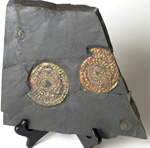 |
Double Rainbow Ammonite Plate. Ammonites that reflect brilliant colors are the most highly valued of ammonites and when cut and polished have the name Ammolite as a gemstone used for jewelry. This pair of 3.25 inch Caloceras jehostoni 150 million year old ammonites come from the lower Lias beds of Somerset, United Kingdom. The brilliant rainbow colors consist of vivid reds, greens, oranges with flashes of yellow. These iridescent colors result from light refracting through the thin platelets of aragonite and conchiolin which are the materials from which the ammonite built it shell. The rainbow ammonites are nicely contrasted against the 10.75 x 9 inch black slate matrix along with a .75 inch ammonite near the corner.
Add $20 for domestic shipping.
Estimated Value $650 - 850.
View details and enlarged photo
| Unsold |
Lot 1126 |
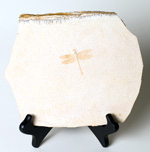 |
Dragonfly From Solnhofen. Solnhofen Germany is well known for having the first bird found in the fossil record, Archaeopterix but one of its other famous and popular fossils is the dragonfly. These 150 million year old dragonflies are beautifully preserved in the fine grain lithographic limestone matrix. This rare species Tarsophlebia exima is perfectly positioned on a 8 x 7 inch limestone matrix with an interesting black dendritic pattern at the top. The dragonfly has a 2 inch long body and a wingspan of 2 inches long and appears to be in flight. This is a complete dragonfly with a well defined head and amazing wing detail where even the most delicate wing membranes are preserved to make this dragonfly one of the finest to be found from the famous lithographic limestone quarry of Solnhofen.
Shipping: $15.
Estimated Value $600 - 800.
View details and enlarged photo
| Unsold |
Lot 1127 |
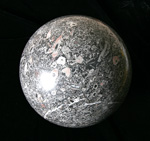 |
Huge 26 Lb Crinoid Sphere. This immense 8.5 inch diameter bowling ball size sphere weighs over 26 pounds and is almost composed entirely of hundreds of plates of crinoid stems that are 150 million years old from Henan Province, China. Crinoids are echinoderms, relatives of starfish and are mostly known from the plates that made up their long stems that were attached to the ocean bottom as they filter fed on small organic creatures. These stems easily broke up into the individual round plates when the crinoid died and in some areas comprise 99% of the fossils found in the rocks. The crinoid stems range in shape from straight sections to round and oval and in color from shades of pink to browns and blacks. Because of the rare pink color of some of the stems, this stone is known as pink marble. This huge fossil sphere should appeal to both fossil and sphere mineral collectors.
Add $20 for domestic shipping.
Estimated Value $400 - 500.
View details and enlarged photo
| Realized
$336 |
Lot 1128 |
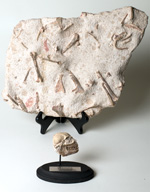 |
Leptomeryx Mass Mortality Plate. Leptomeryx was a 30 million year old extinct mammal of the ruminant genus looking something like a small slender deer. In actuality Leptomeryx is closer related to the modern day mouse deer which also is not a deer. The skull and the mass mortality slab of several different animals were found on private land in the White River Badlands of south Dakota. The 2.5 x 2.3 inch skull is mostly complete missing just the tip of the snout and has excellent teeth on both the upper and lower jaw. The skull is displayed on a 5 x 3 inch black wooden stand with a brass label. The accompanying 13.5 x 11.5 inch original slab of Leptomeryx bones consists of a large 3 inch long lower jaw, 2 partial lower and upper jaws, as well as a number of leg bones and vertebrae bones from at least two different animals. This is an interesting display of an early extinct mammal different from any existing mammals.
Add $30 for domestic shipping.
Estimated Value $700 - 900.
View details and enlarged photo
| Unsold |
Lot 1129 |
 |
Mosasaur Skull- Plioplatecarpus ictericus. Mosasaurs were the T-Rex of the cretaceous seas. All mosasaurs skulls are rare because the skull bones are rather thin and light and easily break apart in the fossilization process. This magnificent 22 x 8 inch skull of Plioplatecarpus ictericus is 70 million years old and was found in Fall River County, South Dakota. It is complete accept some crack repair and some tooth repair and is missing the back of the lower jaw which has been reconstructed and cast from another specimen. There are two rows of pterygoid teeth at the back of the mouth which were used to hold the prey animal while the mosasaur was swallowing it. Mosasaurs had double hinged jaws and probably shared a common ancestor with snakes. It is mounted on a custom black metal stand.
Plioplatecarpus ictericus was discovered and named in 1871 by Othniel Marsh during the Yale expedition along the banks of the Smoky Hill River. This is rare opportunity to acquire an unusual and interesting marine reptile skull.
Add $100 for domestic shipping.
Estimated Value $8,500 - 11,000.
View details and enlarged photo
| Unsold |
Lot 1130 |
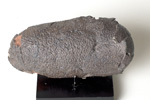 |
Museum Quality Oviraptor Egg. This original unhatched Oviraptor egg is 70-80 million years old from the Djadokhta formation of Ukhaa Tolgod of Mongolia. This egg was found in the Gobi desert and is just over 6.5 inches long and belongs to the largest of the two Oviraptor species called Citipati to distinguish this difference from the other smaller species. Citipati Oviraptorids were made famous by the nest of eggs with the mother Citipati sitting on top of the eggs in a brooding position. This famous specimen is displayed in the New York Museum of Natural History and was discovered in 1995. It was revolutionary to discover a dinosaur sitting on top of its eggs like a bird and only later was it discovered that Oviraptors such as Citipati also had feathers like a bird. Citipati eggs are ratite in texture and have a very thin shell which is why they are rarely found complete. This premium quality egg is slightly compressed from being buried under layers of rock and has sharp textured detail on the shell with over 95% original shell and has been fully airbrushed resulting in a highly detailed dark brown shell. Because of their thin shell most Oviraptor eggs have less than 50 % original shell, superb museum quality unhatched eggs such as this one are extremely hard to locate.
Add $25 for domestic shipping.
Estimated Value $1,250 - 1,500.
View details and enlarged photo
| Unsold |
Lot 1131 |
 |
Nest of Four Oviraptor Eggs. Oviraptors were strange-looking theropod dinosaurs, toothless with a strong beak and most interestingly found to sit on their eggs like birds until they hatched. The name Oviraptor means egg stealer and they were misnamed this in 1920 when they were first discovered because it was believed they were eating the eggs they were found with instead of sitting on them. The four eggs in this partial nest are fully inflated with some cracks in the thin shell and are 6.5 x 3 inches in a 10 x 10 inch red limestone matrix. The two best of the fully exposed eggs have between 80-90 % of their original light to dark gray black egg shell with the third exposed egg containing about 60% original shell. The fourth egg is still 75% buried in the matrix under the best top two eggs. Oviraptors laid their eggs in two layers one on top of the other as this partially buried egg illustrates. There are at least three species of Oviraptors and they can only be identified by the size of their eggs. These eggs belong to the largest species Citipati which was made famous by the important discovery in 1995 of a mother Oviraptor sitting on a nest of eggs and currently on display at the Museum Of Natural History in New York.
Add $40 for domestic shipping.
Estimated Value $3,000 - 3,500.
View details and enlarged photo
| Unsold |
Lot 1132 |
 |
Orthoceras Nautiloid Plate. This extremely large 20 x 13.5 inch black slate plate contains more than 20 complete light gray Orthoceras nautiloids which were something like armored squid with a shell covering their body and a number of tentacles extending out from the bottom of the shell. They range in size from 2-5 inches and are a lovely light gray color with excellent detail of the chambers that make up their shell. Orthoceras was a straight nautiloid something like an ammonite that has been straightened out. These nautiloids are 385 million years old from the Atlas Mountains of Morocco. They have been polished with their light gray color nicely contrasting with the black slate matrix.
Add $25 for domestic shipping.
Estimated Value $350 - 500.
View details and enlarged photo
| Unsold |
Lot 1133 |
 |
Pair of Rare Ranilla Fossil Crab. The strange shaped extinct Ranilla crab (known as frog crabs) are rare small primitive crabs from the Raninidae family that have adapted their body and claws to deep water. These two specimens are 1.5 x 1.2 inches sitting on a 2 inch stone matrix and have a full carapace, parts of the unusual claws and many legs and mouth parts as well. The large flat claws were modified into tools that the crabs used to dig into the mud at the bottom of the ocean to hide from predators. Even the odd rounded carapace aided quick burial. These rare crabs are 2-4 million years old and only found in one place in the world, Liberty County, Florida. A single specimen sold for $975 several years ago. Comes with a 2 x 2 inch Lucite base.
Add $20 for domestic shipping.
Estimated Value $500 - 800.
View details and enlarged photo
| Unsold |
Lot 1134 |
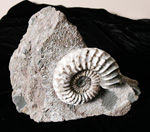 |
Scunthorpe Ammonite. The most beautiful ammonites come from the Jurassic (200 million years old) from the Frodingham Ironstone Quarry in Scunthorpe, UK. This 5.5 inch complete ammonite has lovely white-cream colored chambers with golden sutures between the chambers. It is aesthetically displayed on a 11 x 64 inch natural darker native rock and stands in an upright position making for an excellent display. The ammonites from this quarry are in high collector demand since the quarry has been permanently closed for many years and is now a landfill site.
Add $25 for domestic shipping.
Estimated Value $700 - 1,000.
View details and enlarged photo
| Unsold |
Lot 1135 |
 |
Sea Urchin With Attached Spines. This magnificent 150 million year old sea urchin Pseudocidaris is virtually complete with 23 club-like spines still being in place to create a life-like fossil. This is very rare as the spines easily break off and are rarely found intact as a complete specimen. This unusual fossil is 2.5 x 2.5 inches on a 4X4 inch original stone matrix and was found on Ile de Re (a small island near the Pointe du Chay) France. Sea Urchins which are related to Star Fish have been found in the fossil record for over 300 million years. This museum quality fossil is nicely displayed on a 7 x 4 inch black wooden base.
Add $20 for domestic shipping.
Estimated Value $800 - 1,200.
View details and enlarged photo
| Unsold |
Lot 1136 |
 |
Stingray From Green River. The 50 million year old dry lake beds of Green River, Wyoming are famous for their exquisitely preserved fish and one of the rarest and most desirable fossil fish is the stingray. Stingrays are only rarely found and are usually not complete. This large 14 x 8 inch male Stingray is the exception in that it is 100% complete and original with no restoration. The detail of even the tiniest of bones on its bell are well detailed and the tail ends with 4 sharp stingers with their barbs visible just waiting to be used. You can tell that it is a male because of the two long claspers that extend back away from the body. Only sharks and rays possess these reproducing claspers in males. This museum quality Stingray comes from an old collection and is nicely centered on a 21.75 x 13 inch natural limestone matrix as found.
Add $75 for domestic shipping.
Estimated Value $2,750 - 3,500.
View details and enlarged photo
| Unsold |
Lot 1137 |
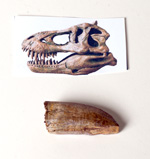 |
T-Rex Pre-Maxilary 1.9 Inch Tooth. Virtually all T-Rex teeth found are shed teeth that broke off when the T-Rex was feeding on some other dinosaur. Usually these teeth are just fragments or are broken into many pieces, but this large 1.9 inch Pre-Maxilary tooth is the exception.
There is no restoration to this magnificent tooth with most of the enamel surface intact and very good serrations. There is some natural feeding wear on the enamel at the tip that occurred when the T-Rex was still alive. This is a large Pre-Maxilary tooth from an adult T-Rex as the Pre-Maxilary teeth are smaller than the teeth further back in the jaw and were used to strip meat from the bone. They are very distinctive in having two rows of serrations close together on the inner curve of the tooth versus having one row of serrations on the opposite sides of the regular teeth. This 65 million year old treasure was found on a private ranch in the Hell Creek Formation of Montana and is displayed in a 5.5 x 4.5 inch Riker Mount.
Add $20 for domestic shipping.
Estimated Value $2,000 - 3,000.
View details and enlarged photo
| Unsold |
Lot 1138 |
 |
Three Eurypterids, Sea Scorpions. Eurypterids also known as sea scorpions were fierce predators in the warm seas 425 million years ago. They grew to over 6 feet long and easily hunted the slow moving armored fish of that era. Eurypterids were related to scorpions and were probably the first animal to leave the sea and crawl out on dry land. These three highly detailed sea scorpions, Eurypteurus remipes come from the famous 425 million year old Fiddler's Green Quarry of Herkimer County, New York. The largest complete specimen is 5 inches long having both paddles, telson (looks like the stinger in a scorpion but was not poisonous) and two of the six walking legs. The other two Eurypterids are 3.5- 4.5 inches long and are fairly complete each missing one of their paddles and one having only a partial telson, but both having several well detailed feather-like walking legs. The delicate walking legs are rarely preserved and all three of these Eurypterids are above average and nicely displayed on a 11 x 8 hard gray matrix.
Add $30 for domestic shipping.
Estimated Value $1,200 - 1,600.
View details and enlarged photo
| Unsold |
Lot 1139 |
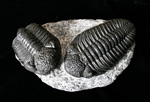 |
Trilobites Two Large Drotops. Trilobites were one of the very first arthropods to have eyes and a hard shell. This advantage made them one of the most successful creatures of all time surviving for more than 250 million years. They became extinct 250 million years ago before there were even dinosaurs.
Most examples of the trilobite Drotops are only 2-3 inches long, but in the warm 375 million year old seas near Erfoud, Morocco this same trilobite grew to almost 6 inches in length. These two large 5.5 x 3 inch black trilobites have been esthetically cut out of their grey stone matrix to crawl in a life-like position on their natural 9 x 5.5 inch gray stone base. Each trilobite is complete with excellent detail on the head with bumps (postules), complete body segments and most of the hexagonal lenses in the eyes. Some trilobites had compound eyes somewhat similar to the compound eyes of a fly.
Add $20 for domestic shipping.
Estimated Value $400 - 600.
View details and enlarged photo
| Realized
$480 |
Lot 1140 |
 |
Two Diplomystus Fish With Signed Matrix. This pair of large 6 inch and 5 inch Diplomystus dentatus has been professionally prepared as a piece of natural artwork on a 20.75 x 13 inch natural limestone matrix. Diplomystus was a surface feeding fish with its distinctive upturned mouth and is extinct with no close living descendents. These 50 million year old Green River Fish are not the normal prepped Green River fish but are completely original and have been artistically cut out of a brownish-orange limestone matrix with a lighter cream colored matrix window cut around each fish making for a dramatic contrast. The two fish themselves have dark brown bones with the brownish-orange matrix beneath the bones making for a really beautiful presentation. This magnificent fossil fish plate has been signed by the master preparer E.G. Ulrich. For the collector wanting the very best museum quality Green River Fish Plate.
Add $30 for domestic shipping.
Estimated Value $600-UP.
View details and enlarged photo
| Unsold |
Lot 1141 |
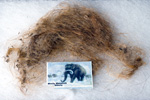 |
Wooly Mammoth Hair. This large specimen of 20,000-30,000 year old Wooly Mammoth hair comes from the only Mammoth specimen available from about a dozen frozen Mammoth carcasses that have been found in the frozen permafrost of the Indi-girka Basin of Siberia. Hair does not fossilize and therefore is extraordinarily rare in extinct animals and definitely contains much original DNA. Currently, there is an analysis of DNA from Mammoth hair similar to this specimen to get enough DNA to create a Wooly Mammoth by impregnating an African Elephant. 80% of the total Mammoth DNA has been collected. This specimen contains much more hair than usually offered and has premium pieces of the long thick reddish-brown hair that covered the body of the Mammoth. This rare specimen of Mammuthis primigenius hair was part of the collection of Dr. Gennady Baryshnikov of the USSR Academy of Sciences in Leningrad, Russia and is housed in a 12 x 8 inch Riker Mount for display.
Add $15 for domestic shipping.
Estimated Value $650 - 1,100.
View details and enlarged photo
| Realized
$456 |
Lot 1142 |
 |
Blue Forest Petrified Wood. The 50 million year old fossilized blue-black wood of the Pepperwood Tree is found only in the Eden Valley of Wyoming. The petrified wood from this area is different from any other fossilized wood known from other areas of the world in that the wood was somehow coated in algae while the wood was immersed in water and later dried and shrunk after being coated in a hard algae mold. Over millions of years surface water entered the spaces left between the dried wood and the algae cast replacing the wood with agate, calcite and quartz. This large 14 x 8 inch trunk section with a thick branch extending out is shaped something like a giant arrowhead and has had its top side polished and coated revealing its signature color pallete from tans to browns to splashes of black as well as areas of the rare blue agate. The edge of the trunk also exhibits cream colored calcite and yellow colored quartz as well as a coating of cream to translucent Chalcedony. Most pieces of fossilized wood from this famous area are rather small sections of branches. This is a rare opportunity to acquire a much larger trunk section with partial branch attached.
Add $30 for domestic shipping.
Estimated Value $400 - 600.
View details and enlarged photo
| Unsold |